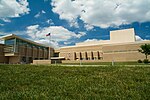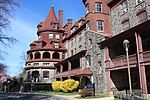Harriton House

Harriton House, originally known as Bryn Mawr, is a historic house on Pennsylvania's Main Line, most famously the residence of Charles Thomson, the secretary of the Continental Congress. It was originally built in 1704 by Rowland Ellis, a Welsh Quaker, and was called Bryn Mawr, meaning high hill. The modern town of Bryn Mawr is named after the house, and the National Register of Historic Places has it listed under the original name. It was originally built as a T-shaped, two-story fieldstone dwelling with a gable roof. The original front section is approximately 37 feet wide and 22 feet deep and the rear extension is approximately 18 feet wide and 23 feet deep. A one-story brick kitchen was added to the end of the rear extension. The house was renovated in 1911 and major additions were made in 1926.It was added to the National Register of Historic Places in 1973.
Excerpt from the Wikipedia article Harriton House (License: CC BY-SA 3.0, Authors, Images).Harriton House
Harriton Road, Lower Merion Township
Geographical coordinates (GPS) Address Nearby Places Show on map
Geographical coordinates (GPS)
| Latitude | Longitude |
|---|---|
| N 40.034722222222 ° | E -75.311388888889 ° |
Address
Harriton House
Harriton Road 500
19010 Lower Merion Township
Pennsylvania, United States
Open on Google Maps





